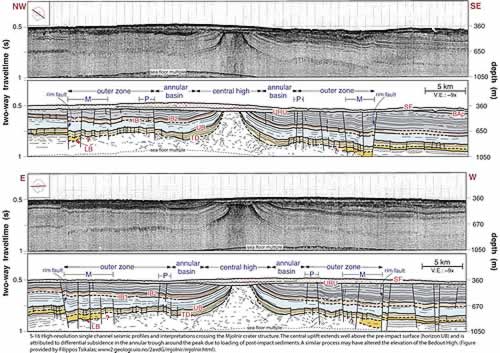|
The seismic profile across Bedout is similar to one across
the 40-km-diameter Mjølnir crater (S-16 below) in the
Barents Sea (38), except the Mjølnir central uplift
is much smaller (1.5-2 km high and 8 km wide). Mjølnir
has a central uplift that extends well above the pre-impact
surface (horizon UB, S-16), and is apparently the result of
differential subsidence in the annular trough around the peak
under the load of post-impact sediments (39). Permian strata
at Bedout are overlain by ~3-5 km of sediment so it is possible
that differential subsidence has altered the relief of the
Bedout High since its initial formation.
 |
S-16. High-resolution single channel
seismic profiles and interpretations crossing the Mjolnir
crater structure. The central uplift extends well above
the pre-impact surface (horizon UB) and is attributed
to differential subsidence in the annular trough around
the peak due to loading of post-impact sediments. A similar
process may have altered the elevation of the Bedout High.
(Figure provided by Filippos Tsikalas; http://folk.uio.no/ftsikala/mjolnir/index.html).
Click here
for a larger view |
Evidence for
a P/Tr Impact in Gondwana
A large impact crater at Bedout is consistent with the global
distribution of impact ejecta in the P/Tr boundary and helps
explain apparent anomalies in the observed patterns. Large
(>200-mm) impact ejecta fragments have, so far, only been
found in the P/Tr boundary at sites relatively close to Bedout
(Fig. 1). Meteorite fragments
from the P/Tr boundary at Graphite Peak in Antarctica range
in size from 50-400-mm (8, Fig.
1). We have found shocked quartz ranging from 150 up to
550 mm in size at Fraser Park, adjacent to the well-known
site at Wybung Head in the Sydney Basin (4) (Fig. 12, S-1a,b)
and up to 250 mm sized grains at Graphite Peak, Antarctica
(Fig. 1, S-1).
 |
| Figure 12. Shocked quartz in the K/T
(yellow circles) and P/Tr (red crosses) boundaries. Shown
is the distribution of the maximum grain size of shocked
quartz with distance from the proposed source crater.
Solid line is a power regression through the K/T data
(42). Click
here for a larger view |
The shocked quartz at Fraser Park and Graphite Peak comprises
~1% of the quartz fraction, compared to ~50% at many K/T boundary
sites (40). Retallack et al. (4) suggested that such a small
amount of shocked quartz in the P/Tr boundary may indicate
a minor impact, but we interpret the low percentage as a product
of dilution by re-working of the ejecta in a continental depositional
environment. The P/Tr boundary layer in the Sydney Basin and
in Graphite Peak is a 10-20 cm thick claystone breccia containing
abundant rip-up clasts from the underlying soil (4), while
the shocked quartz-rich distal K/T boundary deposits are composed
mostly of ejecta and are <1 cm thick (41).
When the maximum grain size of shocked quartz from Fraser
Park and Graphite Peak are plotted with respect to distance
from Bedout, they match well with the maximum sizes for shocked
quartz in the K/T boundary and their distance from Chicxulub
(Fig. 12). Pope (42) demonstrated
that the global shocked quartz distribution in the K/T boundary
is best explained by dispersal by stratospheric winds and
settling of the particles through the atmosphere. Such a dispersal
mechanism is not efficient in latitudinal transport of debris
and, therefore, an impact at Bedout would disperse shocked
quartz mostly over the southern hemisphere. Thus, a large
impact at Bedout is consistent with the size of the shocked
quartz grains found in Australia and Antarctica and may also
explain why such grains are not found further north.
Elsewhere, in China (Meishan) and Japan (Sasayama), Fe-Ni-Si
metal nuggets, oxides, and spherules ~30-200-mm are found
in the P/Tr boundary (5, 6, 8, 43). Similar sized spherules
with refractory grains (Mg-Ni-Fe oxides and Si-Ca-Al oxides)
from the K/T boundary are attributed to formation in the Chicxulub
vapor plume (44), and a similar vapor plume origin has been
proposed for the P/Tr spherules (5, 8). These high-energy
vapor plume products are dispersed much more widely than the
clastic debris (shocked quartz) (42), thus the presence of
vapor plume condensates in China and Japan without shocked
quartz is consistent with an impact at Bedout. The apparent
absence of P/Tr impact ejecta from sites far to the north
of Gondwana, in what is today North America, Europe, and most
of Asia (formerly the Laurasia supercontinent), may also be
a consequence of a far southern hemisphere impact at Bedout,
but more work is needed to verify this hypothesis.
|







